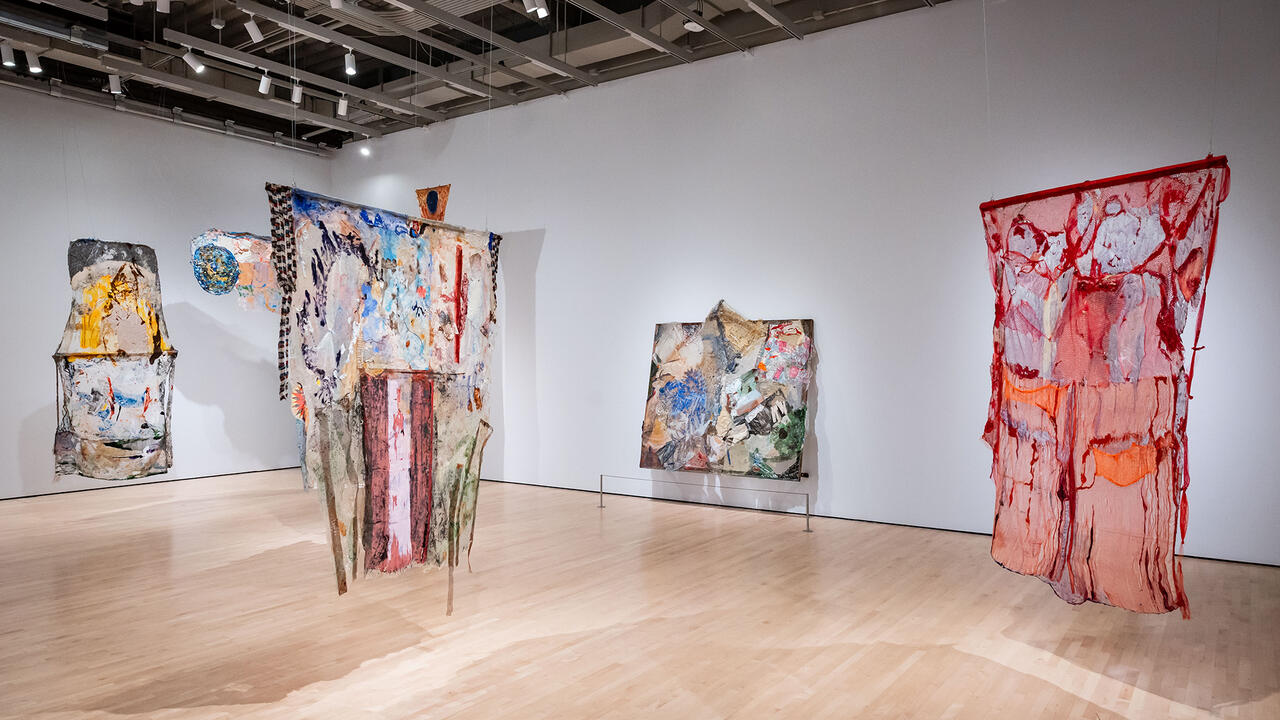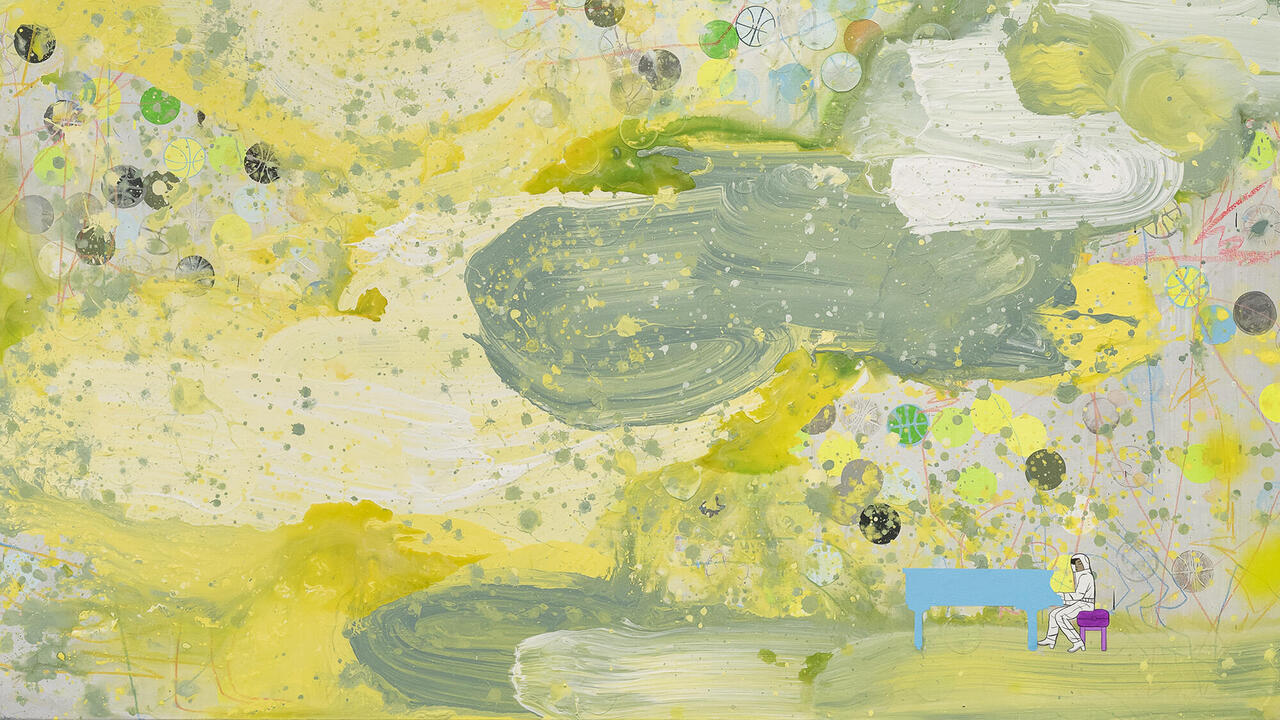Tariq Alvi
2nd Floor Projects, San Francisco, USA
2nd Floor Projects, San Francisco, USA

Made in 1996, Tariq Alvi’s Map of San Francisco transformed a conventional print map of the city into a saturated profusion of primary colours – a kaleidoscopic pattern evoking both Modernist colour grids and the ‘gay flag’ designed by Gilbert Baker in 1978. The affectionately disfigured map longed for San Francisco from a distant remove, as a faraway Utopia of sexual freedom and polymorphous perversity – Alvi had recently graduated from the Jan van Eyck Academie in Maastricht and was then living in the Netherlands. A meditation on sexuality, consumerism, value, disease and disability, his 2005 presentation at the CCA Wattis Institute for Contemporary Art, San Francisco, took a darker tone. Called ‘Super-Pride and Super-Prejudice’, the exhibition again invoked the rainbow flag, but this time as a piece of disconcerting queer kitsch – a massive T-shirt with rainbow letters spelling out ‘I♥Super-HIV’ and a wheelchair covered in cut-outs from gay pornography suspended upside down from the ceiling.
Mounted at 2nd Floor Projects – an apartment gallery located in the Mission and run by the artist Margaret Tedesco – this latest show, titled ‘Hanging Matters’, was a sort of homecoming for the artist. It marked his engagement with the writers Kevin Killian and Dodie Bellamy, to whom Alvi had dedicated two works in the show, folded and framed white handkerchiefs: one for each (Two Hankies, 2005). Killian’s was marked with a stylized horse-head, Bellamy’s with the bust of a woman covered, except for her closed eyes and closed lips, with bandages. For the exhibition Bellamy produced a mesmerizing and self-reflexive text titled, after Alvi’s gift, The Bandaged Lady. In one passage she recounts a phone conversation with Alvi about an image of a hanging. In the voice of the bandaged woman, who observes Killian and Bellamy from an undefined distance, Bellamy writes: ‘When they finally reach him, Tariq tells them about an image he found on the web of two teen boys with their heads in nooses. “They were hanged”, he says, “because they were gay.” “Who hung them?” Dodie asks. “The entire community.”’
That stark image appeared as one element of a mixed-media collage titled The Importance of Hanging (2008), suspended beneath a lavender transparency gel and surrounded by prices cut out from sales circulars. The image of the two young Muslims was at the centre of the picture, their masked executioners half-visible as they placed nooses around the boys’ necks. (‘In later images the hanged boys are swinging,’ the bandaged lady reminds us, ‘their blindfolds have been pulled down and their hands are bound behind their backs.’) The elegance of the picture’s visual form belied its blunt iconographic message. Or did it? Alvi’s collage lacked the elemental clarity of John Heartfield’s designs for Arbeiter-llustrierte-Zeitung or Martha Rosler’s series ‘Bringing the War Back Home: House Beautiful’ (1967–72); instead we were offered sickening conflations. Consumer value is commensurate with the ‘cost’ of life; execution becomes mere ‘image’, immersed in a field of radical reductions – the abstraction and flattening that Karl Marx argues are inherent to value as bare number. To ‘think’ this picture was to enter a vortex and never return.
Matter to Matter and QX International (both 2008) presented a diptych of sorts. Mounted on one wall was a single framed issue of QX Magazine International, ‘a guide to the gay scene in London’. Across the room was a second copy of the same magazine, torn into tiny shreds and then reconstituted into clusters of roughly uniform colour. Attached directly to the gallery wall, they created a constellation of disconnected masses, fragments of text and severed plots of flesh emerging from monochrome asteroids.
The first impression was that Alvi had acted out a calm and meticulous rage against the magazine – its bare consumerism, its presentation of eroticized bodies and social occasions as impoverished opportunities to buy and sell. Yet severed from their original context, the rainbow clusters referred ambiguously back to the Utopian Map of San Francisco. And perhaps further back as well, to Hélio Oiticica’s ‘body of colour’, Ellsworth Kelly’s Spectrum Colours Arranged by Chance (1951) and Piet Mondrian’s ‘new plastic expressions’. From comminuted elements of gay pop life were made to emerge, to borrow the words of Alvi’s London gallerist, Martin McGeown, ‘particles of pictorial energy, bits of broken language, fragments of speech, invented words, a new language, freshly minted’. Haunted by those boys, their image, the appalling price they paid for who they were, Alvi’s ‘new life’ remains inchoate, pure potentiality, but to his credit still tactile, still polymorphous – still present. You can’t walk away from love.






















